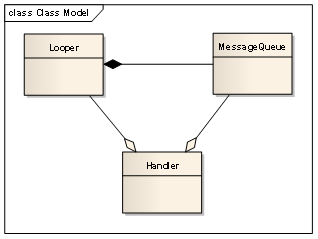前几天,和同事探讨了一下Android中的消息处理机制,探究了消息的发送和接收过程以及与线程之间的关系。虽然我们经常使用这些基础的东西,但对于其内部原理的了解,能使我们更加容易、合理地架构系统,并避免一些低级错误。
对于这部分的内容,将分成4小节来描述:
1、职责与关系
2、消息循环
3、线程与更新
4、几点小结
1、接下来,我们开始这部分的内容,首先了解一下各自的职责及相互之间的关系。
职责
Message:消息,其中包含了消息ID,消息处理对象以及需要处理的数据等,由MessageQueue统一列队,最终由Handler处理。
Handler:处理者,负责Message的发送和处理。使用Handler时,需要实现handleMessage(Message msg)方法来对特定的Message进行处理,例如更新UI等。
MessageQueue:消息队列,用来存放Handler发送过来的消息,并按照FIFO规则执行。当然,存放Message并非实际意义的保存,而是将Message以链表的方式串联起来的,等待Looper的抽取。
Looper:消息泵,不断地从MessageQueue中抽取Message执行。因此,一个MessageQueue需要一个Looper。
Thread:线程,负责调度整个消息循环,即消息循环的执行场所。
关系

Handler、Looper和MessageQueue就是简单的三角关系。Looper和MessageQueue一一对应,创建一个Looper的同时,会创建一个MessageQueue。而Handler与它们的关系,只是简单的聚集关系,即Handler里会引用当前线程里的特定Looper和MessageQueue。
这样说来,多个Handler都可以共享同一个Looper和MessageQueue了。当然,这些Handler也就运行在同一个线程里。
2、接下来,我们简单地看一下消息的循环过程:
生成
Handler.java
/**
* Returns a new {@link android.os.Message Message} from the global message pool. More efficient than
* creating and allocating new instances. The retrieved message has its handler set to this instance (Message.target == this).
* If you don't want that facility, just call Message.obtain() instead.
*/
public final Message obtainMessage()
{
return Message.obtain(this);
}
Message.java
/**
* Same as {@link #obtain()}, but sets the value for the <em>target</em> member on the Message returned.
* @param h Handler to assign to the returned Message object's <em>target</em> member.
* @return A Message object from the global pool.
*/
public static Message obtain(Handler h) {
Message m = obtain();
m.target = h;
return m;
}
/**
* Return a new Message instance from the global pool. Allows us to
* avoid allocating new objects in many cases.
*/
public static Message obtain() {
synchronized (sPoolSync) {
if (sPool != null) {
Message m = sPool;
sPool = m.next;
m.next = null;
sPoolSize--;
return m;
}
}
return new Message();
}
发送
Handler.java
/**
* Enqueue a message into the message queue after all pending messages
* before the absolute time (in milliseconds) <var>uptimeMillis</var>.
* <b>The time-base is {@link android.os.SystemClock#uptimeMillis}.</b>
* You will receive it in {@link #handleMessage}, in the thread attached
* to this handler.
*
* @param uptimeMillis The absolute time at which the message should be
* delivered, using the
* {@link android.os.SystemClock#uptimeMillis} time-base.
*
* @return Returns true if the message was successfully placed in to the
* message queue. Returns false on failure, usually because the
* looper processing the message queue is exiting. Note that a
* result of true does not mean the message will be processed -- if
* the looper is quit before the delivery time of the message
* occurs then the message will be dropped.
*/
public boolean sendMessageAtTime(Message msg, long uptimeMillis)
{
boolean sent = false;
MessageQueue queue = mQueue;
if (queue != null) {
msg.target = this;
sent = queue.enqueueMessage(msg, uptimeMillis);
}
else {
RuntimeException e = new RuntimeException(
this + " sendMessageAtTime() called with no mQueue");
Log.w("Looper", e.getMessage(), e);
}
return sent;
}
在Handler.java的sendMessageAtTime(Message msg, long uptimeMillis)方法中,我们看到,它找到它所引用的MessageQueue,然后将Message的target设定成自己(目的是为了在处理消息环节,Message能找到正确的Handler),再将这个Message纳入到消息队列中。
抽取
Looper.java
/**
* Run the message queue in this thread. Be sure to call
* {@link #quit()} to end the loop.
*/
public static void loop() {
Looper me = myLooper();
if (me == null) {
throw new RuntimeException("No Looper; Looper.prepare() wasn't called on this thread.");
}
MessageQueue queue = me.mQueue;
// Make sure the identity of this thread is that of the local process,
// and keep track of what that identity token actually is.
Binder.clearCallingIdentity();
final long ident = Binder.clearCallingIdentity();
while (true) {
Message msg = queue.next(); // might block
if (msg != null) {
if (msg.target == null) {
// No target is a magic identifier for the quit message.
return;
}
long wallStart = 0;
long threadStart = 0;
// This must be in a local variable, in case a UI event sets the logger
Printer logging = me.mLogging;
if (logging != null) {
logging.println(">>>>> Dispatching to " + msg.target + " " +
msg.callback + ": " + msg.what);
wallStart = SystemClock.currentTimeMicro();
threadStart = SystemClock.currentThreadTimeMicro();
}
msg.target.dispatchMessage(msg);
if (logging != null) {
long wallTime = SystemClock.currentTimeMicro() - wallStart;
long threadTime = SystemClock.currentThreadTimeMicro() - threadStart;
logging.println("<<<<< Finished to " + msg.target + " " + msg.callback);
if (logging instanceof Profiler) {
((Profiler) logging).profile(msg, wallStart, wallTime,
threadStart, threadTime);
}
}
// Make sure that during the course of dispatching the
// identity of the thread wasn't corrupted.
final long newIdent = Binder.clearCallingIdentity();
if (ident != newIdent) {
Log.wtf(TAG, "Thread identity changed from 0x"
+ Long.toHexString(ident) + " to 0x"
+ Long.toHexString(newIdent) + " while dispatching to "
+ msg.target.getClass().getName() + " "
+ msg.callback + " what=" + msg.what);
}
msg.recycle();
}
}
}
在Looper.java的loop()函数里,我们看到,这里有一个死循环,不断地从MessageQueue中获取下一个(next()方法)Message,然后通过Message中携带的target信息,交由正确的Handler处理(dispatchMessage()方法)。
处理
Handler.java
/**
* Handle system messages here.
*/
public void dispatchMessage(Message msg) {
if (msg.callback != null) {
handleCallback(msg);
} else {
if (mCallback != null) {
if (mCallback.handleMessage(msg)) {
return;
}
}
handleMessage(msg);
}
}
/**
* Subclasses must implement this to receive messages.
*/
public void handleMessage(Message msg) {
}
在Handler.java的dispatchMessage(Message msg)方法里,其中的一个分支就是调用handleMessage方法来处理这条Message,而这也正是我们在职责处描述使用Handler时需要实现handleMessage(Message msg)的原因。
至于dispatchMessage()方法中的另外一个分支,我将会在后面的内容中说明。
至此,我们看到,一个Message经由Handler的发送,MessageQueue的入队,Looper的抽取,又再一次地回到Handler的怀抱。而绕的这一圈,也正好帮助我们将同步操作变成了异步操作。
3、剩下的部分,我们将讨论一下Handler所处的线程及更新UI的方式。
在主线程(UI线程)里,如果创建Handler时不传入Looper对象,那么将直接使用主线程(UI线程)的Looper对象(系统已经帮我们创建了);在其它线程里,如果创建Handler时不传入Looper对象,那么,这个Handler将不能接收处理消息。在这种情况下,通用的作法是:
class LooperThread extends Thread {
public Handler mHandler;
public void run() {
Looper.prepare();
mHandler = new Handler() {
public void handleMessage(Message msg) {
// process incoming messages here
}
};
Looper.loop();
}
}
在创建Handler之前,为该线程准备好一个Looper(Looper.prepare()),然后让这个Looper跑起来(Looper.loop()),抽取Message,这样,Handler才能正常工作。
因此,Handler处理消息总是在创建Handler的线程里运行。而我们的消息处理中,不乏更新UI的操作,不正确的线程直接更新UI将引发异常。因此,需要时刻关心Handler在哪个线程里创建的。
如何更新UI才能不出异常呢?SDK告诉我们,有以下4种方式可以从其它线程访问UI线程:
· Activity.runOnUiThread(Runnable)
· View.post(Runnable)
· View.postDelayed(Runnable, long)
· Handler
其中,重点说一下的是View.post(Runnable)方法。在post(Runnable action)方法里,View获得当前线程(即UI线程)的Handler,然后将action对象post到Handler里。在Handler里,它将传递过来的action对象包装成一个Message(Message的callback为action),然后将其投入UI线程的消息循环中。在Handler再次处理该Message时,有一条分支(未解释的那条)就是为它所设,直接调用runnable的run方法。而此时,已经路由到UI线程里,因此,我们可以毫无顾虑的来更新UI。
4、几点小结
Handler的处理过程运行在创建Handler的线程里
· 一个Thread对应一个Looper
· 一个Looper对应一个MessageQueue
· 一个Looper可以对应多个Handler
· 不确定当前线程时,更新UI时尽量调用post()方法
转载自:
http://www.cnblogs.com/xirihanlin/archive/2011/04/11/2012746.html